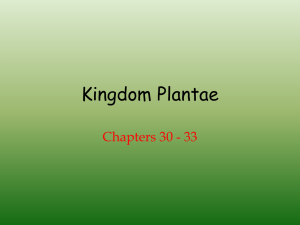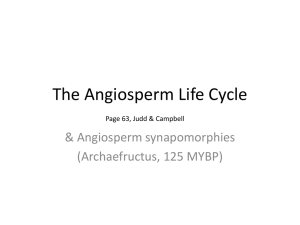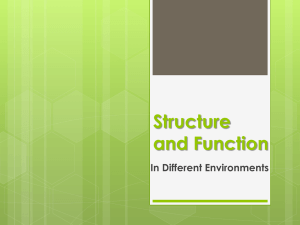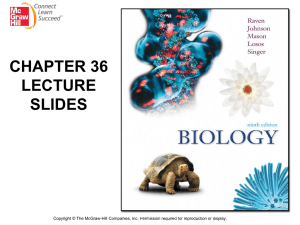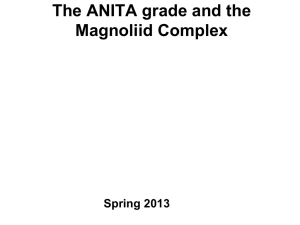Plant Biology Power Point
advertisement
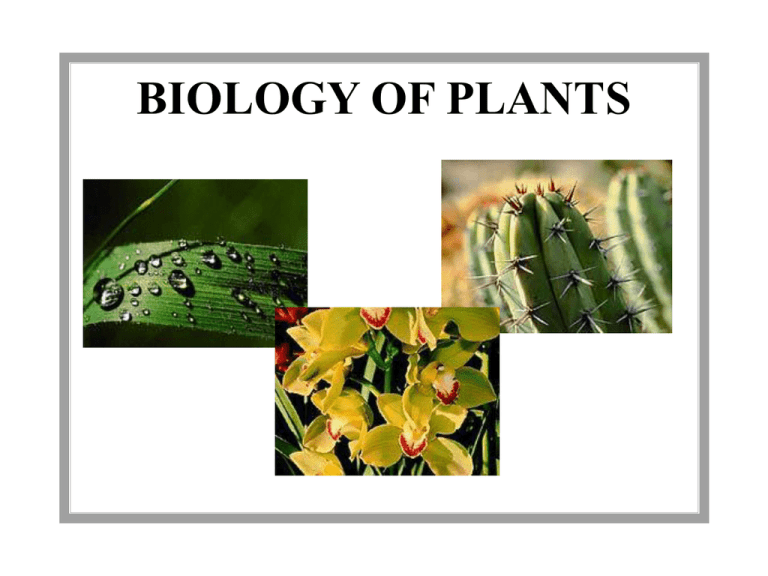
BIOLOGY OF PLANTS Kingdom of Plants • Plants are alive, just like people and animals. • • • • • They grow and die. They need energy, nutrients, air, and water. They produce young. They are made up of cells. They react to what's around them. Specialized Structures • Specialized Structures 1. Some plant parts are greatly modified, and these may look very different from the "typical" plant part. For example: a. A potato is an underground stem, modified for storage. b. Cactus spines are leaves, modified to protect the plant. c. A radish is a root, modified for storage. d. Some orchids perform photosynthesis only with their (above-ground) roots. 2. Structures that look the same to us may be made of different plant parts in different kinds of plants. For example, spines, thorns, and prickles are all sharp plant parts that protect the plant from herbivores. Depending upon the kind of plant, spines may be made from many different plant parts: a. Leaves - e.g., cacti b. Stipules - e.g., Euphorbia (African plant that looks very much like a cactus) c. Shoots - e.g., buckthorn d. Epidermal Hairs - e.g., roses e. Roots - e.g., some tropical trees Plant Physiology A. Plants are photosynthetic -- they gather their food energy directly from sunlight B. To perform photosynthesis, plants need to have a supply of: 1.Sunlight 2.Carbon dioxide gas from the atmosphere 3.Water 4.Mineral nutrients What Do Plants Need to Make Food? • Plants need several things to make their own food. They need: • chlorophyll, a green pigment found in the leaves of plants (see the layer of chlorophyll in the cross-section of a leaf below) •light (either natural sunlight or artificial light, like from a light bulb) •carbon dioxide (CO2)(a gas found in the air; one of the gases people and animals breathe out when they exhale) •water (which the plant collects through its roots) •nutrients and minerals (which the plant collects from the soil through its roots) What Do Plants Need to Make Food? Plants make food in their leaves. The leaves contain a pigment called chlorophyll, which colors the leaves green. Chlorophyll can make food the plant can use from carbon dioxide, water, nutrients, and energy from sunlight. This process is called photosynthesis. Basic Plant Structure • Plants have three vegetative organs: – roots, – stems, – and leaves. Shoot System 1. 2. Shoots are made of leaves attached to a stem. Leaf (singular; plural is leaves) Leaves are often the primary site of photosynthesis. a. Leaf Blade - large, flat part of leaf that collects sunlight. b. Petiole - narrow stick that holds leaf blade away from the stem. c. Leaf Base - slight broadening at base of petiole, protects bud when leaf is young, and may include stipules. d. Simple Leaves - leaf blade is composed of only one piece. e. Compound Leaves - leaf blade is divided into two or more leaflets. In some plants the leaflets of compound leaves look very similar to leaves, but only true leaves have buds in their axils Root System 1. The root anchors the plant in the soil, absorbs water and mineral nutrients from the soil, and often serves for storage. 2. Roots are underground, so people don't think very much about them, but they are very important. 3. Branch Roots a. Roots do not have leaves or axillary buds b. Branch roots emerge from the inside of the root c. Root Hairs d. Absorption e. Found just behind growing tip of root f. Root Cap g. Protects the delicate tip of the root as it grows through the soil. h. Found in front of the root apical meristem. Stem System Holds leaves, transports and stores water and nutrients, and is sometimes photosynthetic. Tissue System and Its Functions Component Tissues Dermal Tissue System • protection • prevention of water loss Ground Tissue System • photosynthesis • food storage • regeneration • support • protection Epidermis Periderm (in older stems and roots) Vascular Tissue System • transport of water and minerals • transport of food Xylem tissue Phloem tissue Parenchyma tissue Collenchyma tissue Sclerenchyma tissue Location of Tissue Systems Dermal Tissues • The dermal tissue system protects the soft tissues of plants and controls interactions with the plants' surroundings. • The epidermis is a dermal tissue that is usually a single layer of cells covering the younger parts of a plant. It secretes a waxy layer called the cuticle that inhibits water loss. Dermal Tissues • Most epidermal cells lack chloroplasts. Most epidermal cells lack chloroplasts. Guard cells contain chloroplasts and regulate gas exchange between the inside of the leaf and the surrounding air. Dermal Tissues Glandular hairs prevent herbivory by storing substances that are harmful to insects. Epidermal hairs lower water loss by decreasing the flow of air over the plant surface, which in turn, slows the loss of water from the plant. Vascular Tissue Xylem Tissue Phloem Tissue Function • Function •Conduct water and dissolved minerals • Support •Conduct food and other organic substances Cell Types Unique to This Tissue Additional Cell Types in This Tissue Tracheids Vessel members Companion Cells Parenchyma cells Fibers Sieve-tube elements Parenchyma cells Fibers Primary Growth • Primary growth is the lengthening of the stem and roots. – All plant growth occurs by cell division and cell elongation. Cell division occurs primarily in regions of undifferentiated cells known as meristems. – Cell division in the apical meristems and subsequent elongation and maturation of the new cells produces primary growth. – The other type of growth, secondary growth, is the increase in girth of stems and roots. Primary Growth of Stems • The apical meristem produces the three primary meristems, protoderm, procambium, and ground meristem, which develop into dermal tissues, vascular tissues, and ground tissues respectively. Primary Growth of Stems • Meristems are regions of embryonic tissue capable of growing into new plant parts. Meristems are found in both roots and shoots. 1. Primary meristems make the shoot or root grow longer. This kind of growth is called primary growth. a. A shoot apical meristem is found within each bud. b. A root apical meristem is found at the tip of each root, and is protected by the root cap. 2. Secondary meristems make the stem or root grow larger in diameter. This kind of growth is called secondary growth. Not all kinds of plants are capable of secondary growth. Secondary growth gives rise to wood, and plants that are not capable of secondary growth do not develop wood. Plant Reproduction A. Asexual Reproduction 1. Because plant growth is indeterminate, each meristem can potentially develop into a complete plant. This means that it is very easy to clone plants, and many plants can grow from cuttings or broken plant parts. This is asexual reproduction (also called vegetative reproduction). B. Sexual Reproduction 1. Alternation of Generations - plant sexual reproduction is unusual, and involves an alternation between two partially independent life stages. We will discuss this later in the course. 2. Flowers are special reproductive structures found in the Flowering Plants (=Angiosperms) 3. A flower is a specialized shoot, adapted for sexual reproduction. 4. A fruit develops from a flower following fertilization. 5. Other plants perform sexual reproduction, but do not use flowers, and do not form fruit. Pollination • Pollination is the transfer of pollen from a stamen to a pistil. Pollination starts the production of seeds. • To be pollinated, pollen must be moved from a stamen to the stigma. When pollen from a plant's stamen is transferred to that same plant's stigma, it is called self-pollination. Helpful terms • Herbaceous: Plants with stems that are usually soft and bendable. Herbaceous stems die back to the ground every year. • Woody: Plants with stems, such as tree trunks, that are hard and do not bend easily. Woody stems usually don't die back to the ground each year. • Photosynthesis: A process by which a plant produces its food using energy from sunlight, carbon dioxide from the air, and water and nutrients from the soil. • Pollination: The movement of pollen from one plant to another. Pollination is necessary for seeds to form in flowering plants. Plant Adaptations • Plants have adaptations to help them survive (live and grow) in different areas. Adaptations are special features that allow a plant or animal to live in a particular place or habitat. These adaptations might make it very difficult for the plant to survive in a different place. This explains why certain plants are found in one area, but not in another. For example, you wouldn't see a cactus living in the Arctic. Nor would you see lots of really tall trees living in grasslands. Tundra Desert Grassland In Water Temperate Rain Forest Taiga Temperate Deciduous Forest Tropical Rain Forest Major Plant Groups • We are going to examine several groups that show these trends: – 1. bryophytes: nonvascular plants including liverworts and mosses – 2. seedless vascular plants such as ferns and horsetails – 3. gymnosperms, which have seeds and a vascular system, such as the conifers – 4. angiosperms, the flowering plants that dominate the world today. Bryophytes • The bryophytes include the mosses, liverworts, and hornworts. They are short plants mostly growing in wet environments. • Bryophytes have a waxy cuticle on their leaves to prevent dessication. • Bryophytes have no internal vascular system. •Bryophytes spend most of their lives as haploids: the body of the moss plant is haploid. •The only diploid structure is a stalk and spore capsule, which grow out of the haploid plant body. Bryophyte Life Cycle • The haploid gametophyte plant bodies are either male or female. Each produces a different kind of gamete (eggs or sperm). • The sperm are motile: they swim through drops of water (rain or dew) to reach the eggs. The eggs are encased within the female gametophyte’s body. Bryophyte Life Cycle •After fertilization, the diploid sporophyte grows as a stalk out of the female gametophyte’s body. •After the diploid sporophyte matures, the cells in it undergo meiosis, forming haploid spores. •The haploid spores disperse in the wind, and go on to form new gametophyte plants. Seedless Vascular Plants • The seedless vascular plants include ferns and horsetails. • A vascular system to distribute nutrients throughout the plant allows them to grow tall. Some ferns grow up to 80 feet tall, and some extinct horsetails were also tree-sized. • Being seedless means that the diploid sporophyte grows out of the fertilized egg, attached to the gametophyte. Fern Life Cycle • The main plant body in the diploid sporophyte. Specialized structures on the underside of the leaves develop, and inside them meiosis occurs. • The haploid meiotic products are released as spores, which are dispersed to new locations and germinate into gametophytes. Fern Life Cycle •The haploid gametophytes are quite small, a few millimeters in diameter. They contain structures that produce sperm and eggs. •The sperm swim to the eggs and fertilize them •The fertilized eggs are diploid, and they grow into the sporophyte plant body. Seeds and Pollen • A major development in plant evolution was the development of pollen grains and seeds. • Pollen grains are the male gametophyte packaged in a hard coat that allows it to reach the female without having to swim through water. This is a large advantage on dry land. • Seeds are diploid sporophyte embryos, packaged to survive a period of dormancy and bad environmental conditions. Seeds develop from the fertilized egg. Gymnosperms • Gymnosperms were the first plants to have pollen grains and seeds. • Gymnosperm means “naked seed”: their seeds develop on the outside of the plant, instead of inside an ovary as in the flowering plants. • The most important gymnosperms today are the conifers: pines, redwoods, cedars, etc. All are woody plants with needles or scales as leaves. • Conifers are our main source of wood and paper. • Ginkos and cycads are other gymnosperms. Angiosperms • Angiosperms are flowering plants. Most of the plants we see are angiosperms. • Unlike the other plant groups, angiosperms are often fertilized with the aid of animals: insects, birds, bats, that carry the pollen from one plant to another. The plants and their pollinators have coevolved in a symbiotic relationship. • Flowers produce the visual signals and the scents that pollinators use to find the plants. Flowers secrete nectar which is eaten by the pollinators. The pollen is carried from flower to flower on the body of the pollinator, as a consequence of its going into the flower in search of nectar. • Some angiosperms have wind-dispersed pollen. Flowers on these plants are usually small and inconspicuous.







